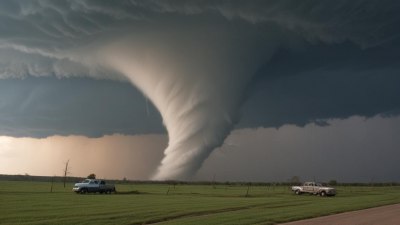Why Tornadoes Are Hard to Predict
Explore the complexities of tornado prediction and why it remains a significant challenge in meteorology.

This image was created with the assistance of Freepik
Tornadoes are among the most destructive weather phenomena on Earth, capable of inflicting catastrophic damage within minutes. Despite advancements in meteorology and technology, predicting tornadoes remains a formidable challenge. Several factors contribute to this difficulty, ranging from the inherent unpredictability of the atmosphere to limitations in observational data and forecasting techniques.
The Complexity of Atmospheric Conditions
The atmosphere is a dynamic and intricate system, with countless variables influencing weather patterns. Tornado formation typically requires specific conditions, including warm, moist air at the surface meeting cooler, dry air aloft, creating instability. Additionally, strong winds at different altitudes can contribute to the rotation necessary for tornado formation. A precise combination of these conditions must align perfectly, making it inherently challenging to predict when and where a tornado will spawn.
While meteorologists utilize advanced technology such as Doppler radar and weather satellites, these tools have limitations. Doppler radar can detect rotation in thunderstorms, which is a precursor to tornado formation, but it cannot forecast the exact time or location of a tornado's development. Moreover, radar data can be affected by distance and terrain, leading to blind spots. Despite these advancements, the short lead time for warnings often leaves little room for public preparedness.
Weather prediction suffers from the effects of chaos theory. The atmosphere is sensitive to initial conditions, meaning that small, seemingly insignificant changes can lead to vastly different outcomes. This chaotic nature makes long-term forecasting challenging because accurate predictions can quickly degrade over time. Tornadoes can form unexpectedly within larger storm systems, often caught in the chaotic interplay of atmospheric forces that make precise predictions elusive.
Climate change is also complicating tornado prediction efforts. As global temperatures rise, weather patterns are shifting, leading to changes in tornado frequency, intensity, and seasonality. These alterations can disrupt established forecasting models, making it harder to anticipate how future tornadoes will behave. Ongoing research is critical to understanding these changes and improving prediction methodologies.
Another significant aspect of tornado prediction is public education. Many people believe that they can predict tornadoes based on anecdotal evidence or personal experience, which can lead to complacency during severe weather events. Accurate public education about the signs of tornadoes and the importance of relying on meteorological expertise is essential for improving community preparedness and response.
Investing in research and development is crucial for enhancing tornado prediction capabilities. This includes refining forecasting models, improving observational networks, and integrating machine learning and artificial intelligence to analyze vast amounts of meteorological data. Collaborative efforts between meteorologists, climatologists, and data scientists can lead to innovative approaches that enhance prediction accuracy.
As technology evolves, new methods of tornado prediction are emerging. For instance, researchers are exploring the use of unmanned aerial vehicles (UAVs) or drones equipped with sensors that can collect real-time data in storm environments. This data could improve forecasting models and offer unprecedented insights into the dynamics of tornado formation, ultimately leading to better prediction capabilities.
While advancements in technology may improve tornado prediction, it is essential to acknowledge current limitations. Tornadoes can form rapidly and with little warning, sometimes within minutes of detection. Therefore, it is crucial for communities in tornado-prone areas to have robust emergency plans and remain vigilant during severe weather warnings, even when predictions are made.
Predicting tornadoes is a complex endeavor that continues to challenge meteorologists worldwide. The interplay of atmospheric conditions, technological limitations, chaotic systems, and the impacts of climate change all contribute to the difficulties in forecasting these violent storms. As research and technology improve, there is hope for better prediction capabilities, but the unpredictable nature of tornadoes means that caution and preparedness remain essential in tornado-prone areas.
In summary, understanding why tornadoes are hard to predict is multifaceted, requiring an appreciation of atmospheric dynamics, advances in forecasting technology, and continuous research efforts. As our understanding grows, so too does the potential for improved safety and preparedness in the face of these powerful natural disasters.











